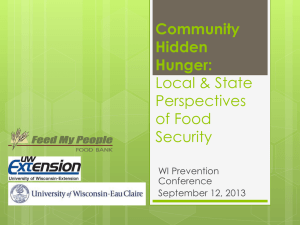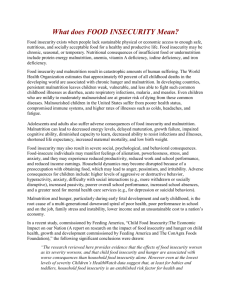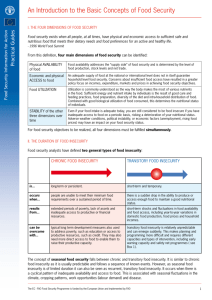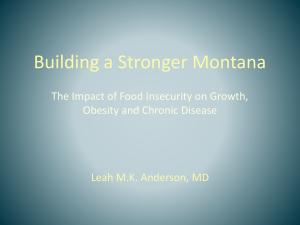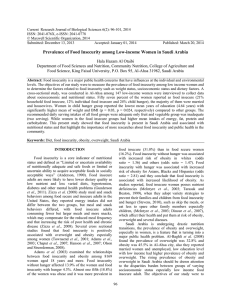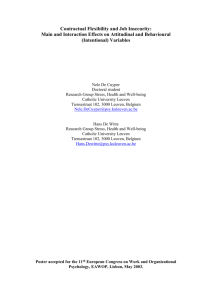Food Insecurity and Education
advertisement
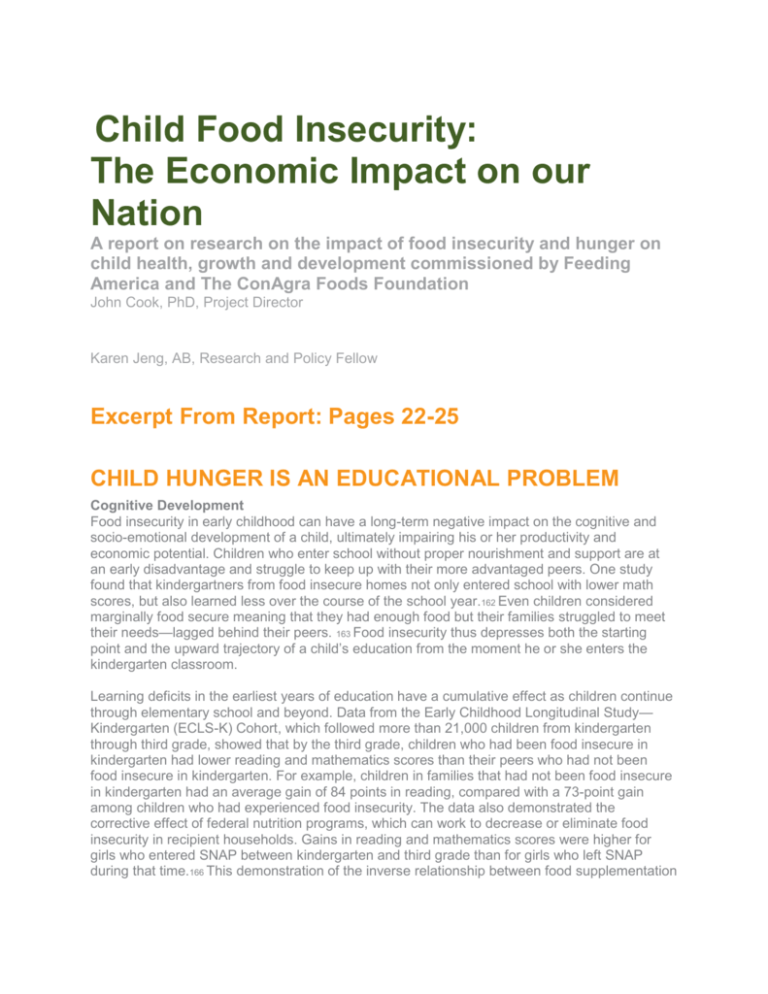
Child Food Insecurity: The Economic Impact on our Nation A report on research on the impact of food insecurity and hunger on child health, growth and development commissioned by Feeding America and The ConAgra Foods Foundation John Cook, PhD, Project Director Karen Jeng, AB, Research and Policy Fellow Excerpt From Report: Pages 22-25 CHILD HUNGER IS AN EDUCATIONAL PROBLEM Cognitive Development Food insecurity in early childhood can have a long-term negative impact on the cognitive and socio-emotional development of a child, ultimately impairing his or her productivity and economic potential. Children who enter school without proper nourishment and support are at an early disadvantage and struggle to keep up with their more advantaged peers. One study found that kindergartners from food insecure homes not only entered school with lower math scores, but also learned less over the course of the school year.162 Even children considered marginally food secure meaning that they had enough food but their families struggled to meet their needs—lagged behind their peers. 163 Food insecurity thus depresses both the starting point and the upward trajectory of a child’s education from the moment he or she enters the kindergarten classroom. Learning deficits in the earliest years of education have a cumulative effect as children continue through elementary school and beyond. Data from the Early Childhood Longitudinal Study— Kindergarten (ECLS-K) Cohort, which followed more than 21,000 children from kindergarten through third grade, showed that by the third grade, children who had been food insecure in kindergarten had lower reading and mathematics scores than their peers who had not been food insecure in kindergarten. For example, children in families that had not been food insecure in kindergarten had an average gain of 84 points in reading, compared with a 73-point gain among children who had experienced food insecurity. The data also demonstrated the corrective effect of federal nutrition programs, which can work to decrease or eliminate food insecurity in recipient households. Gains in reading and mathematics scores were higher for girls who entered SNAP between kindergarten and third grade than for girls who left SNAP during that time.166 This demonstration of the inverse relationship between food supplementation and cognitive delay shows once again the dynamic effect of nutrition upon cognitive development in young children. Food insecurity has a continuing negative impact on the cognitive and academic development of children as they grow older. Educational achievement through the middle and secondary school years depends on students mastering basic skills and building on their knowledge over time. Food insecure children learn at a slower rate than their peers, and that fact coupled with their initial delay leaves them further and further behind as they progress through the educational system. Studies have found that elementary school students from food insecure homes have significantly lower mathematics scores and are more likely to have repeated a grade than their peers from food secure homes.167 Case Study: Special Education Food insecurity increases the likelihood that a child will be judged to need special educational services; at the worst end of the spectrum, children who are not only food insecure but are classified as hungry are twice as likely as those who are not hungry to be receiving special education services, and twice as likely to have repeated a grade.168 According to the U.S. Department of Education, special education services cost an extra $5,918 per pupil in schoolyear 1999-2000. As the national average per pupil cost of public education is around $6,800 (fiscal year 2001), the additional cost of special education services brings the total cost of educating a special needs child to nearly double the annual expenditure for a child without special needs.169 Once they begin to receive special education, children typically stay within the special needs system for the remainder of their school career, so the nearly $6,000 additional cost accrues annually until they leave the school system. For a special-needs kindergartener, then, progress through the eighth grade alone represents approximately $54,000 in additional expenditures on the part of the school system, and indirectly, on the part of the taxpayer. Socio-emotional and Behavioral Consequences When their ability to provide a nutritious diet and regular meals for their children is uncertain, parents feel anxiety 23 and frustration, leading to high levels of stress. Stress within the household in turn takes a toll on young children, and can cause serious behavioral and emotional issues that can impair mental health and social adjustment. Using the ECLS-K, researchers have found that even after controlling for other variables, food insecure kindergarteners were rated by their parents as having a poorer emotional state (less self-control, higher levels of sadness, loneliness, impulsiveness, and overactivity), and by both their parents and teachers as having lower social ability scores, in comparison to their food secure peers.170 Another study, the CCHIP, found that school-age children who are hungry and at-risk for hunger are more likely to have problems with hyperactivity, absenteeism, and generally poor behavioral and academic functioning than their not-hungry peers.171 Older children continue to show the negative effects of food insecurity. Elementary school-aged children who are food insecure not only have an increased prevalence of negative behavioral and health outcomes172, but are more than twice as likely to have seen a psychologist.173 By the time they are teenagers, food insecure children are twice as likely as their peers to have seen a psychologist, twice as likely to have been suspended from school, and have greater difficulty getting along with other children.174 The damaging effects of the lack of a stable food source are even greater in children classified as hungry, the most severe level of food insecurity. For both preschoolers and school-aged children, child hunger is associated with higher rates of internalizing problems and child anxiety.175 By elementary school, researchers have found that children who are hungry are four times more likely than non-hungry children to have a history of needing mental health counseling; seven times more likely to be classified as clinically dysfunctional; seven times more likely to get into fights frequently; and twelve times more likely to steal. 176 Behavioral problems like aggression and stealing often lead to contact with the criminal justice system. Besides the economic and emotional toll crime takes on its victims and society, the public also bears the substantial costs of incarceration. For 2006, the U.S. Justice Department estimates that it cost an average of $63 per day to imprison an inmate, or nearly $23,000 each year.177 As many criminals cycle in and out of the justice system over their lifetimes, the costs can multiply dramatically. Though food insecurity is only one factor in the complex mix of influences that predispose individuals to criminal behavior, its very real influence on brain architecture and chemistry at an early age, and its impact on social and emotional health during critical years of socialization make it responsible for at least a fraction of the enormous costs that crime imposes on the broader society. Children who struggle in school with lower grades, difficult social interactions, and repeating grades are also at a much greater risk of dropping out in high school, an outcome with dramatic economic consequences. In 2006, the median annual income for a high school dropout was only $18,868; that was $8,516 less than a high school graduate and $27,567 less than a college graduate.178 A study of dropouts in Massachusetts estimates that over the course of their working career, a dropout will earn $500,000 less than a high school graduate and almost $2 million less than a college graduate.179 As low-income workers are less likely to hold jobs with benefits like health insurance, pensions or retirement plans, they fall even further physically and financially behind those who graduate. Society, in turn, bears the costs of increased health problems, lost worker productivity, and lost tax revenue as individuals achieve and earn less. Lifetime Earnings A person’s earning capacity is determined largely by educational attainment in the U.S. and elsewhere. When human capital deficits (e.g., health problems, including those correlated with food insecurity) interfere with cognitive development, achievement of school readiness, learning or academic achievement, they can impact educational attainment and reduce one’s earning capacity. Reduced earning capacity, in turn, reduces that person’s lifetime earnings, and their economic contribution to the social and economic systems. Such impairments of one person’s earning capacity do not only impact that person and her/his contribution to society, they also can impact their children’s human capital accumulation and earning capacity. This is the pattern suggested by the term “cycle of poverty,” in which the impacts of one generation’s poverty present barriers to the next generation’s achievement of its potential (Karp, 1993).18024 Table 2 shows median annual income levels for people ages 25 years and above with different levels of educational attainment in the U.S. in 2007, along with the net present value of simplified hypothetical earnings streams at these levels over 40 years (out to retirement at age 65 years). The median and lifetime earnings for earners with professional degrees (medical, legal, etc.) are nearly five times as great as those for earners without a high school degree. These lifetime earning-stream estimates are very conservative since they do not include pay raises or investment earnings over the 40-year period. Yet they illustrate the magnitude of differences in lifetime earnings arising from different levels of human capital accumulation. They also illustrate the magnitude of forgone income that can result from failure to attain one’s academic potential. Food insecurity problems have been shown to adversely impact school performance and academic achievement. To the degree that food insecurity is a factor inhibiting educational attainment, it also limits lifetime earnings and the contribution such forgone earnings would make as they multiplied and rippled through the economy. Footnotes for Excerpted Section: 163 Ibid. 164 Jyoti, D. et. al. (2005). Food insecurity affects school children’s academic performance, weight gain, and social skills. J. Nutr. 135:2831-2839. 165 The Condition of Education (2004). Students’ Reading and Mathematics Achievement Through 3rd Grade. National Center for Education Statistics 2004. 166 Frongillo, E. et. al. (2006). Food Stamp Program participation is associated with better academic learning among school children. J. Nutr. 136:1077-1080. K. et. al. (2001). Food insufficiency and American school-aged children’s cognitive, academic, and psychosocial development. Pediatrics 108(1):44-53. 167 Alaimo, 168 Kleinman, R. et. al. (1998). Hunger in children in the United States: Potential behavioral and emotional correlates. Pediatrics 101(1):e3. 169 Skelly, Thomas. Director, Budget Service, U.S. Department of Education. Letter to the Hon. Patsy Mink, 2001. http://www.ed.gov/policy/speced/guid/idea/letters/revpolicy/tpusefundsallgrnts.html 170 Stormer, A. and G.G. Harrison (2003). Does household food insecurity affect cognitive and social development of kindergarteners? California Center for Population Research, University of California—Los Angeles, November 2003. 171 Murphy, J.M. et. al. (1998). Relationship between hunger and psychosocial functioning in low-income American children. Journal of the American Academy of Child and Adolescent Psychiatry 37(2):163-170. 172 Dunifon, R. and L. Kowaleski-Jones (2003). The influences of participation in the National School Lunch Program and food insecurity on child well-being. Social Service Review March 2003:72-92. 32 173 Alaimo, K. et. al. (2001). Food insufficiency and American school-aged children’s cognitive, academic, and psychosocial development. Pediatrics 108(1):44-53. 174 Ibid. 175 Weinreb, L. et. al. (2002). Hunger: Its impact on children’s health and mental health. Pediatrics 110(4):e41. 176 Kleinman, R. et. al. (1998). Hunger in children in the United States: Potential behavioral and emotional correlates. Pediatrics 101(1):e3. 177 Office of the Federal Detention Trustee (2004). FY 2008 Performance Budget. U.S. Department of Justice, Congressional Budget Submission. http://www.usdoj.gov/jmd/2008justification/pdf/05_ofdt.pdf. 178 U.S. Census Bureau, Current Population Survey, Annual Social and Economic Supplement, 2007. 179 Boston Youth Transitions Task Force (2006). Too big to be seen: The invisible dropout crisis in Boston and America. A Report from the Boston Youth Transitions Task Force, May 2006. 180 Karp, R.J., Malnourished children in the United States: caught in the cycle of poverty. Springer Pub. Co. New York, 1993. 181 Current Population Survey 2007. 182 Economic Research Service 2007. 183 Ohls, J., et. al., 2002. 184 Food Stamps as Medicine: A New Perspective on Children’s Health. February 2007. R., et. al., 2008. 185 Rose-Jacobs,
